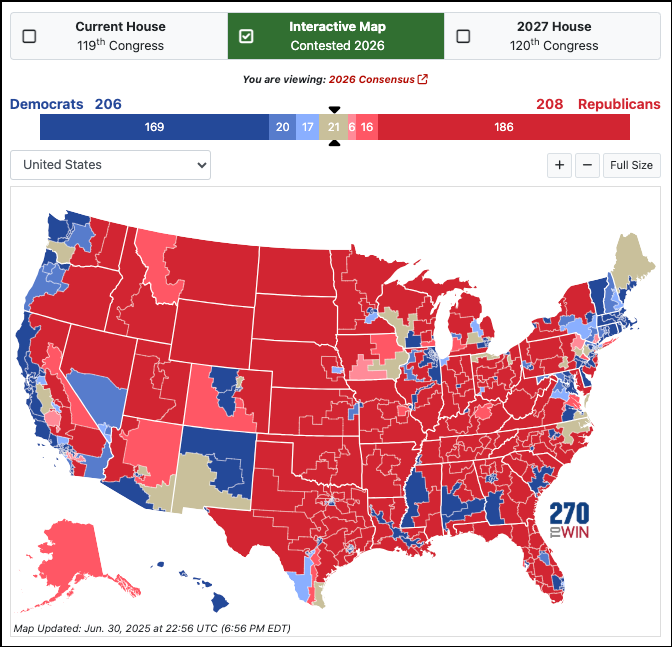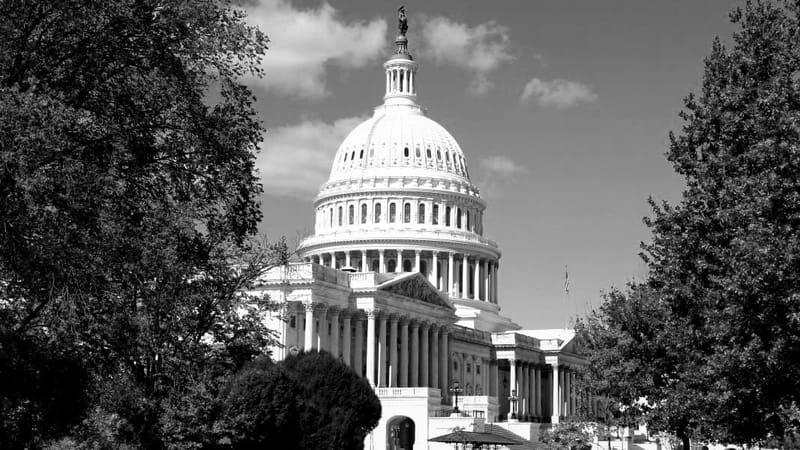Redistricting battles by the numbers—How redistricting could reshape the 2026 House of Representatives
A wave of potential mid-decade redistricting could tip control of the House in 2026, with Republicans seeking up to a dozen new seats in states like Texas and Ohio, while Democrats look to counter in California and Illinois.

Republicans enter the late summer of 2025 holding a narrow grip on the U.S. House of Representatives, with 219 seats to the Democrats’ 212, alongside four vacancies. That slim edge will be tested in the 2026 midterm elections, when all 435 congressional districts go before voters.
Ordinarily, midterms hinge on national mood and swing-seat dynamics, however, this cycle carries an additional layer: new political maps could be drawn in several states before ballots are cast. Former President Donald Trump’s call for Texas Republicans to carve out five new GOP-leaning districts has opened the door to a wave of potential mid-decade redistricting across the country. From California to Florida, lawmakers are debating whether to alter the lines in ways that could significantly reshape the partisan balance in the House.
This report sets out to analyse just how much those changes might matter. By combining the current partisan breakdown with the latest consensus forecasts, we can assess both moderate expectations and extreme scenarios to show how redistricting could tilt control of the House in 2026.
Current Landscape
As of August 2025, the House stands at 219 Republicans, 212 Democrats, and 4 vacancies following the deaths of three members and the resignation of one. That leaves Republicans with a paper-thin majority heading into the midterms.

Looking ahead, the 270toWin consensus forecast provides a snapshot of the battlefield: 208 Republican-leaning seats, 206 Democratic-leaning seats, and 21 toss-ups. These toss-up districts, scattered across states like California, New York, Ohio, and Pennsylvania, represent the true ground zero for the fight for control.
The toss-ups alone are enough to decide the majority. But when combined with the prospect of mid-decade redistricting in as many as eight states, the path to 218 seats becomes more complex—and potentially more lopsided—depending on how the maps are drawn.
States in Play
According to NPR, at least eight states are weighing mid-decade redistricting ahead of the 2026 midterms, an unusually large wave of changes outside the standard post-census cycle. Here's how it breaks down per state.
Texas
At the center of the national fight, Texas could deliver the largest single gain for Republicans. Gov. Greg Abbott is moving forward with plans to draw five additional GOP-leaning congressional districts, a move urged by Donald Trump. Democrats temporarily stalled the process by breaking quorum and leaving the state, but Abbott has pledged to keep redistricting at the top of the legislative agenda until a new map is passed.
California
In a direct response, Gov. Gavin Newsom has proposed a November 2025 ballot measure that would amend the state Constitution to temporarily allow five new Democratic-leaning districts. The measure is explicitly conditional: it would only take effect if GOP-led states such as Texas or Ohio redraw their maps first.
The proposal would consolidate diverse urban and suburban communities, with several districts projected to have majority-Latino or majority-minority voting-age populations.
For a closer look at how these districts could reshape the map, explore the interactive California redistricting map below:
Missouri
Republicans in Missouri are weighing whether to dismantle the Kansas City–based district of Rep. Emanuel Cleaver, a Democrat. Doing so could turn it into a solid Republican seat, effectively flipping the state’s balance from 6R–2D to 7R–1D. Yet the plan faces constitutional uncertainty, since Missouri’s charter is unclear on whether redistricting can legally occur outside the post-census cycle.
Ohio
Ohio is unique in that its 2018 redistricting reforms require a mid-decade redraw after lawmakers failed to produce a bipartisan map. Republicans see an opportunity to target three Democratic incumbents—Marcy Kaptur, Emilia Sykes, and Greg Landsman—with the potential to net two or even three additional seats. Given the GOP tilt of the state, Ohio is one of the most consequential battlegrounds for redistricting gains.
New York
In New York, Democratic leaders are eager to take another shot at drawing a favorable map, but the state constitution restricts redistricting to once per decade. Any change before 2027 would require a successful lawsuit or constitutional amendment, making new lines before the 2026 midterms essentially off the table.
Illinois
In Illinois, Gov. JB Pritzker has left the door open to redrawing the state’s congressional map, but the prospects remain narrow. Democrats already maximized their advantage when Illinois lost a seat after the 2020 census, leaving just three heavily Republican districts. While some strategists suggest it might be possible to squeeze out one additional Democratic seat, legislative leaders have been hesitant to reopen what was already a politically charged process.
Indiana
In Indiana, Republicans are eyeing the district of Democratic Rep. Frank Mrvan in the northwest corner of the state. Flipping it would reduce the state’s delegation to 8 Republicans and 1 Democrat. While Indiana’s constitution limits legislative redistricting to the census cycle, the GOP supermajority could attempt to change state law to enable a congressional redraw.
Florida
Florida remains a legal flashpoint. The current map, pushed through by Gov. Ron DeSantis in 2022, eliminated a Black access district in North Florida and helped Republicans capture more seats. With the Florida Supreme Court upholding much of that map, GOP leaders are now exploring whether other districts could be redrawn under similar reasoning. That could mean one or two more Republican seats, though it risks further litigation under the state’s Fair Districts Amendments.
Potential Seat Shifts by State: Quick Guide
| State | Potential Shift | Notes |
|---|---|---|
| Texas | +5 R | Abbott pushing to create 5 new GOP-leaning districts at Trump’s request. |
| California | +5 D | Newsom’s ballot measure (Nov. 2025), conditional on GOP states redrawing first. |
| Missouri | +1 R | Could dismantle Rep. Cleaver’s district; faces constitutional challenges. |
| Ohio | +2–3 R | Mid-decade redraw required by 2018 reforms; GOP targeting Kaptur, Sykes, Landsman. |
| New York | 0 | Constitution limits redistricting to once per decade; no change before 2027. |
| Illinois | +1 D | Possible extra Dem seat, but internal resistance and few GOP targets. |
| Indiana | +1 R | GOP aiming to flip Frank Mrvan’s seat; constitutional/legal hurdles remain. |
| Florida | +1–2 R | Legal fights over Fair Districts Amendments; DeSantis-led map already favored GOP. |
Aggregate Seat Shifts
When the potential changes across all eight states are added together, the picture becomes clearer.
- Republican-controlled states (Texas, Missouri, Ohio, Indiana, Florida) could collectively generate +10 to +12 seats for the GOP if they push maps to the partisan maximum.
- Democratic-controlled states (California and Illinois) could counter with +5 to +6 new Democratic seats.
- The net effect, if every effort succeeds, is a Republican advantage of roughly +4 to +7 seats nationwide—enough to solidify the party’s majority even before toss-up districts are decided.
Extreme Scenarios
Scenario 1: GOP Maxes Out
In the most aggressive Republican scenario, the party wins all 21 toss-ups projected by 270toWin and pushes through maximum redistricting gains in Texas, Missouri, Ohio, Indiana, and Florida.
Result: 241 Republicans, 194 Democrats
Implication: A 47-seat GOP majority, the party’s strongest position in more than a decade.
Scenario 2: Democrats Max Out
On the other end, Democrats win all 21 toss-ups and secure redistricting victories in California and Illinois, while Republican-led states hold their current maps.
Result: 233 Democrats, 202 Republicans
Implication: A 31-seat Democratic majority, reversing the current balance of power heading into 2027.
Middle Case / Realistic Range
The most plausible outcome lies between these extremes. If the 21 toss-ups split roughly evenly and only partial redistricting succeeds, the outcome is likely to look like this:
- Republicans: 218–220 seats
- Democrats: 211–212 seats
That would leave Republicans with a narrow but workable edge, demonstrating how decisive both contested swing seats and mid-decade redistricting will be in shaping the 120th Congress.
Legal and Political Barriers
Even with ambitious redistricting plans on both sides, significant hurdles remain.
- Missouri, Ohio, and Florida: Any new maps are almost certain to face court challenges. Missouri’s constitution is ambiguous about whether mid-decade redistricting is even permissible, Ohio’s Supreme Court has struck down partisan maps in the past, and Florida’s “Fair Districts” amendments continue to provide grounds for litigation.
- California: Gov. Gavin Newsom’s push for five new Democratic seats hinges on a ballot measure in November 2025. Even if passed, the changes would only take effect if Republican states redraw first, leaving its implementation uncertain.
- Illinois: Although Gov. JB Pritzker is open to squeezing out another Democratic seat, legislative leaders have shown little appetite for another politically charged remap. Internal resistance within the party could stall any effort.
Implications for 2026
The bottom line is that Republicans may be able to lock in their House majority through redistricting alone, regardless of how toss-up districts break. With potential gains in Texas, Ohio, and Florida, the GOP could build a structural advantage before a single vote is cast in competitive seats.
For Democrats, the only realistic counterweight lies in California’s ballot measure, which, if approved, could generate as many as five new Democratic-leaning districts. Without it, the Democratic path to a majority depends heavily on sweeping toss-ups.
The broader implication is sobering: control of the House may hinge less on swing voters and more on who controls the mapmaking process in a handful of states.
Conclusion
Redistricting is shaping up to be the hidden battlefield of the 2026 midterms. Beyond the usual jockeying for swing districts, the lines themselves could decide which party enters 2027 in control of the House.
Depending on how these maps unfold, margins could swing by as much as 30 to 40 seats in either direction—enough to produce either a commanding Republican majority or a surprising Democratic comeback.
The stakes extend well beyond the next Congress. The outcome of 2026 will set the stage for the 2028 presidential election, determining which party controls the House gavel during what promises to be another high-stakes national contest.






